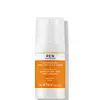What's inside
What's inside
 Key Ingredients
Key Ingredients

 Benefits
Benefits

 Concerns
Concerns

 Ingredients Side-by-side
Ingredients Side-by-side

Water
Skin ConditioningUndecane
EmollientGlycerin
HumectantCaprylic/Capric Triglyceride
MaskingTridecane
PerfumingPolyglyceryl-3 Polyricinoleate
EmulsifyingPolyglyceryl-4 Isostearate
EmulsifyingButyrospermum Parkii Butter
Skin ConditioningShea Butter Ethyl Esters
EmollientAvena Sativa Kernel Oil
Skin ConditioningSorbitol
HumectantSimmondsia Chinensis Seed Oil
EmollientJojoba Esters
EmollientXylitylglucoside
HumectantSilica
AbrasiveSodium Chloride
MaskingAnhydroxylitol
HumectantCoco-Caprylate/Caprate
EmollientHelianthus Annuus Seed Wax
Skin ConditioningPropanediol
SolventBenzyl Alcohol
PerfumingHydroxyacetophenone
AntioxidantStearalkonium Hectorite
Gel FormingXylitol
HumectantGlycogen
HumectantPolyglyceryl-3 Ricinoleate
EmulsifyingDisteardimonium Hectorite
StabilisingSodium Hyaluronate
HumectantPropylene Carbonate
SolventGlucose
HumectantSambucus Nigra Flower Extract
RefreshingAcacia Decurrens Flower Wax
EmollientPolyglycerin-3
HumectantTocopherol
AntioxidantCitric Acid
BufferingWater, Undecane, Glycerin, Caprylic/Capric Triglyceride, Tridecane, Polyglyceryl-3 Polyricinoleate, Polyglyceryl-4 Isostearate, Butyrospermum Parkii Butter, Shea Butter Ethyl Esters, Avena Sativa Kernel Oil, Sorbitol, Simmondsia Chinensis Seed Oil, Jojoba Esters, Xylitylglucoside, Silica, Sodium Chloride, Anhydroxylitol, Coco-Caprylate/Caprate, Helianthus Annuus Seed Wax, Propanediol, Benzyl Alcohol, Hydroxyacetophenone, Stearalkonium Hectorite, Xylitol, Glycogen, Polyglyceryl-3 Ricinoleate, Disteardimonium Hectorite, Sodium Hyaluronate, Propylene Carbonate, Glucose, Sambucus Nigra Flower Extract, Acacia Decurrens Flower Wax, Polyglycerin-3, Tocopherol, Citric Acid
Propylene Glycol
HumectantGlycerin
HumectantSodium Ascorbyl Phosphate
AntioxidantPolysorbate 60
EmulsifyingDimethicone
EmollientPhenoxyethanol
Preservative1-Methylhydantoin-2-Imide
Skin ConditioningCitric Acid
BufferingCaprylyl Glycol
EmollientXanthan Gum
EmulsifyingParfum
MaskingDisodium EDTA
Polyacrylamide
Benzophenone-4
UV AbsorberC13-14 Isoparaffin
EmollientSodium Hydroxide
BufferingLaureth-7
EmulsifyingCitrus Paradisi Fruit Extract
Skin ConditioningPotassium Sorbate
PreservativeSodium Benzoate
MaskingCitral
PerfumingCitronellol
PerfumingCI 14700
Cosmetic ColorantCI 15985
Cosmetic ColorantAcrylates/C10-30 Alkyl Acrylate Crosspolymer
Emulsion StabilisingWater
Skin ConditioningPropylene Glycol, Glycerin, Sodium Ascorbyl Phosphate, Polysorbate 60, Dimethicone, Phenoxyethanol, 1-Methylhydantoin-2-Imide, Citric Acid, Caprylyl Glycol, Xanthan Gum, Parfum, Disodium EDTA, Polyacrylamide, Benzophenone-4, C13-14 Isoparaffin, Sodium Hydroxide, Laureth-7, Citrus Paradisi Fruit Extract, Potassium Sorbate, Sodium Benzoate, Citral, Citronellol, CI 14700, CI 15985, Acrylates/C10-30 Alkyl Acrylate Crosspolymer, Water
 Reviews
Reviews

Ingredients Explained
These ingredients are found in both products.
Ingredients higher up in an ingredient list are typically present in a larger amount.
Citric Acid is an alpha hydroxy acid (AHA) naturally found in citrus fruits like oranges, lemons, and limes.
Like other AHAs, citric acid can exfoliate skin by breaking down the bonds that hold dead skin cells together. This helps reveal smoother and brighter skin underneath.
However, this exfoliating effect only happens at high concentrations (20%) which can be hard to find in cosmetic products.
Due to this, citric acid is usually included in small amounts as a pH adjuster. This helps keep products slightly more acidic and compatible with skin's natural pH.
In skincare formulas, citric acid can:
While it can provide some skin benefits, research shows lactic acid and glycolic acid are generally more effective and less irritating exfoliants.
Most citric acid used in skincare today is made by fermenting sugars (usually from molasses). This synthetic version is identical to the natural citrus form but easier to stabilize and use in formulations.
Read more about some other popular AHA's here:
Learn more about Citric AcidGlycerin is already naturally found in your skin. It helps moisturize and protect your skin.
A study from 2016 found glycerin to be more effective as a humectant than AHAs and hyaluronic acid.
As a humectant, it helps the skin stay hydrated by pulling moisture to your skin. The low molecular weight of glycerin allows it to pull moisture into the deeper layers of your skin.
Hydrated skin improves your skin barrier; Your skin barrier helps protect against irritants and bacteria.
Glycerin has also been found to have antimicrobial and antiviral properties. Due to these properties, glycerin is often used in wound and burn treatments.
In cosmetics, glycerin is usually derived from plants such as soybean or palm. However, it can also be sourced from animals, such as tallow or animal fat.
This ingredient is organic, colorless, odorless, and non-toxic.
Glycerin is the name for this ingredient in American English. British English uses Glycerol/Glycerine.
Learn more about GlycerinWater. It's the most common cosmetic ingredient of all. You'll usually see it at the top of ingredient lists, meaning that it makes up the largest part of the product.
So why is it so popular? Water most often acts as a solvent - this means that it helps dissolve other ingredients into the formulation.
You'll also recognize water as that liquid we all need to stay alive. If you see this, drink a glass of water. Stay hydrated!
Learn more about Water